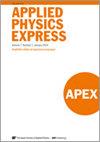基于环形磁偶极模式的中空米氏谐振器可提高折射传感的灵敏度
IF 2.2
4区 物理与天体物理
Q3 PHYSICS, APPLIED
引用次数: 0
摘要
我们提出了一种基于环形磁偶极模式空心硅米氏谐振器的折射传感器。该模式具有一对垂直于硅基板的反平行电偶极子;因此,该模式的辐射受到抑制,从而产生了 0.35 nm 的超窄反射峰线宽。此外,中空结构增强了增强电场与周围介质之间的相互作用,从而提高了灵敏度。所提出的米氏谐振器的灵敏度达到 486 nm/RIU,优点系数高达 1389 RIU-1,是折射传感的理想选择。本文章由计算机程序翻译,如有差异,请以英文原文为准。
Hollow Mie resonators based on toroidal magnetic dipole mode with enhanced sensitivity in refractometric sensing
We propose a refractometric sensor based on hollow silicon Mie resonators of a toroidal magnetic dipole mode. This mode has a pair of antiparallel electric dipoles perpendicular to the silica substrate; thus, the radiation of the mode is suppressed, resulting in an ultra-narrow reflection peak linewidth of 0.35 nm. In addition, the hollow structure enhances the interaction between the enhanced electric field and the surrounding medium, thus improving the sensitivity. The proposed Mie resonators achieve a sensitivity of 486 nm/RIU and a figure of merit up to 1389 RIU−1, which are ideal for refractometric sensing.
求助全文
通过发布文献求助,成功后即可免费获取论文全文。
去求助
来源期刊

Applied Physics Express
物理-物理:应用
CiteScore
4.80
自引率
8.70%
发文量
310
审稿时长
1.2 months
期刊介绍:
Applied Physics Express (APEX) is a letters journal devoted solely to rapid dissemination of up-to-date and concise reports on new findings in applied physics. The motto of APEX is high scientific quality and prompt publication. APEX is a sister journal of the Japanese Journal of Applied Physics (JJAP) and is published by IOP Publishing Ltd on behalf of the Japan Society of Applied Physics (JSAP).
 求助内容:
求助内容: 应助结果提醒方式:
应助结果提醒方式:


